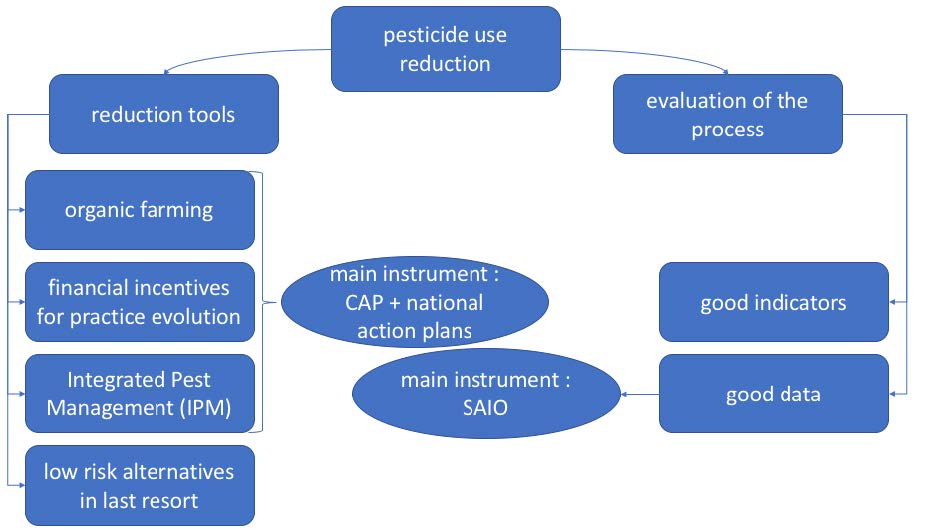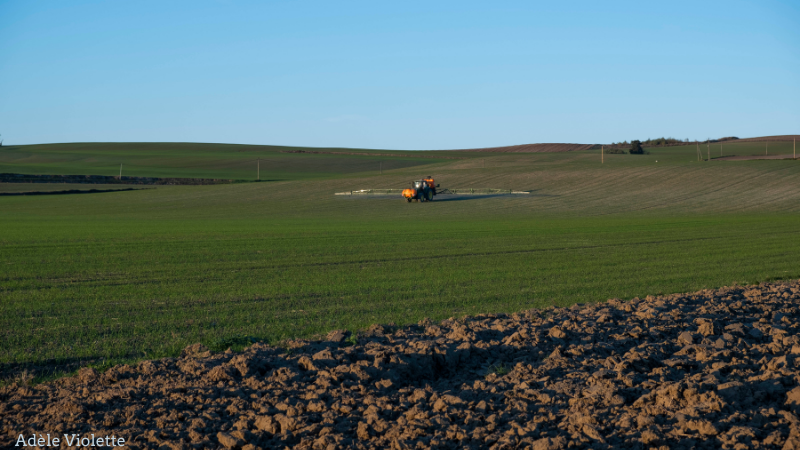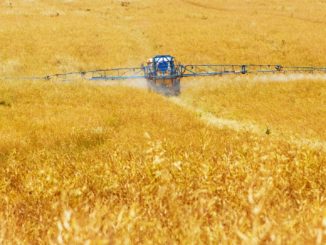
On June 22nd, the European commission presented a new regulation on the sustainable use of plant protection products. Originally scheduled in March, it had been postponed in order to deal with the invasion of Ukraine and food security debate that then erupted. This regulation is a long awaited response to the insufficient results of the Sustainable Use of Pesticide Directive (SUD) that framed the use of pesticides since 2009. Conclusions from many reports, including a report from the Court of Auditors, have shown that there had been very little progress in reducing use and risks for the environment and human health of pesticides. With 75% of food production depending on pollination , the urgency of the situation is alarming and a strong response is needed. Here, we will have a quick look at this regulation and check if the CAP Strategic Plans can provide good tools to help reach the ambition of the text.
By Mathieu Willard
A quick look at the new proposal
At first glance, this new proposal is a big improvement on the previous directive. For a start, the legal framework is evolving from a directive to a regulation, legally binding for all member states.
Two strong rules have been included as centrepieces of the text : the enforcement of an overall EU reduction of 50% of use and risk of pesticides by 2030, and the complete ban of pesticide use in all sensitive areas, including ecologically sensitive areas. To reach this goal, each Member State will be setting their own targets.
However there is still the possibility that, with a provided justification, targets as low as 35% can be proposed.
As was the case in the previous directive, the success of this regulation will strongly depend on the CAP, as it will be central in enforcing the application of the Integrated Pest Management (IPM) principles, and the only source of EU financing.
Member States on the offensive
The new regulation proposal was the main point on the agenda of the last agrifish council, on July 18th. During the council, Member States haven’t been short on critics of the text. Most Member States insisted on prioritising food security – seen as maintaining current production capacities – when establishing national targets. Members States were also generally opposed to the complete pesticide ban in sensitive areas, many stating it would ruin production capacities, some countries having large portions of their agricultural land in sensitive areas (almost all in Malta). Moreover, Member States have insisted on the importance of considering historical progress and other national specificities. They also pointed out the risk of increasing administrative burden and the lack of effective alternatives for farmers. Some Member States were also concerned with the lack of good data available to evaluate the effectiveness of the regulation as well as the opacity surrounding the weighting factors of the Harmonized Risk Indicator (HRI-1) which is the main indicator proposed to evaluate progress towards the target of 50% reduction.
This vocal criticism was predictable as many Member States had already been trying to water down the regulation in June and have also been active in watering down complementary legislation.
A complex and multifactorial puzzle
Although we will not linger on all those factors in this article, it is important to note the crucial complementarity of different legislations and action plans in order to achieve the pesticide reduction objectives.

Figure 1 : overview of the pesticide reduction requirements
First, the Statistics on Agricultural Input and Output legislation (SAIO) must provide quality and frequent data to be able to analyse the ongoing reduction. While it has been welcomed that yearly data on pesticide use and electronic collection of farmers’ records will be implemented, there are still concerns with the timing. Indeed, the first year this data would be collected is 2028 with 2026 as reference year. This delay will make monitoring for the 2030 reduction objective impossible.
Second, the main indicator used for monitoring (Harmonised Risk Indicator 1 (HRI-1)) has been found inappropriate in multiple reports (Here the report from PAN Europe, Global 2000, the European Court of Auditors). Those reports show that deficiencies, notably in risk weighting factors linked to active substances, render the indicator ineffective in estimating the actual reduction in risk and use of pesticide. The indicator also overestimates the risk of natural substances used in organic farming.
Better data collection and better indicators are crucial to seriously tackle our pesticide dependency and this necessity has been long established by the court of auditors’ report, back in 2020.
CAP Strategic Plans at the rescue?
The above deficiencies should be of great concern to anyone who really wants to achieve the Farm to Fork Strategy objectives in pesticide use reduction. Moreover, it is also essential to check if Member States have the right reduction tools and related financing at their disposal to initiate concrete reductions on the ground.
In terms of European tools, the new pesticide regulation is proposing two main ways of action. The first is an enforcement of IPM, the second, an “exceptional EU support” through the CAP Strategic Plans (CSPs).
IPM and GAECs
The 2009, still in application, pesticide directive already made it mandatory for farmers to apply IPM as of 2014. National Action Plans were to be established to ensure, among other objectives, this enforcement. Despite those rules, the European Court of Auditors reported only limited compliance in Member States, mainly because of a lack of clear criterias to assess and lax CAP conditionalities that are supposed to set up minimal requirements encompassing the IPM principles. In the new CSPs, the problem doesn’t seem to have been resolved.

On GAECs, GAEC 4, requiring the establishment of buffer strips along watercourses, GAEC 7, requiring crop rotation on arable land and GAEC 8, establishing minimum shares of land to non-productive areas, are all linked to IPM principles. Unfortunately, none of them seem to meet expectations, either because of lack of ambition in the original CSP regulation, or by way of derogations in the Strategic Plans. In the table below, we summarise the CSP screening made by EEB and Birdlife on the topic for 8 Member States (Poland, Latvia, Sweden, Germany, Spain, Italy, Czech Republic and Slovakia).
| Recommendations | EU CSP Regulation | CAP Strategic Plans implementation | |
| GAEC 4 | The European Food Safety Authority (EFSA) fixes buffer strips at between 10 and 50m for pesticides next to water courses. | -Minimum width of 3m.
-Derogation : for small irrigation ditches when justified. |
Many Member States will use the possibility to not apply minimum width to small drainage ditches, which don’t fit the water course description, even though this may well result in the contamination of water courses.
Ex.: Poland, Latvia, Spain |
| GAEC 7 | The IPM principles indicate that crop rotation and diversification with resistant/tolerant cultivars is essential.
|
-Mandatory crop rotation.
-Derogation : Possibility to authorise crop diversification instead of rotation upon justification. |
Many Member States will not be implementing crop rotation at all. Others are strongly restricting the contexts in which the rotation is mandatory.
Ex.: Latvia, Sweden will not implement crop rotation. In Italy, too many excemptions are making the rule ineffective. Germany, Czech Republic and Slovakia will implement crop rotation only. Spain will implement both. |
| GAEC 8 | Studies have shown that at least 10% of high diversity landscape features and non-productive areas are needed to start to restore agricultural ecosystems | – Minimum share of 3-4 % of arable land at farm level devoted to non-productive areas and features.
|
No Member States goes higher than the mandatory minimum. 17 of the 28 CSPs offer the possibility to include productive elements with no benefit for biodiversity. |
Table 1 : summary of IPM principles compliance in 8 CSPs, source : EEB, Birdlife
It is also of great importance to note that the commission recently decided to authorise the contested derogation on GAEC 7 and GAEC 8, for productivity purposes, for the year 2023 (We’ve already discussed this issue in previous articles, showing the absurdity of this decision). It will not surprise anyone that almost all Member States have decided to use the derogation on both GAECs for next year. Here (C(2022)5479), you can find the list of Member States and derogations they will implement.
Finally, the conditionality of the CAP doesn’t only rely on GAECs. It also includes Statutory Management Requirements (SMR) that link CAP payments to the respect of other complementary EU legislations. SMR 7 and SMR 8 are specifically linking CAP payments to the compliance of rules from the SUD and EU Regulation on plant protection products. But neither SMR 7 nor SMR 8 include articles enforcing IPM as a mandatory principle.
Timing is everything
The fact that the 2023-2027 CAP still refers to the SUD directive in its conditionality shows another big issue for the new pesticide regulation proposal – timing. In effect, the new pesticide regulation is counting on the new CAP to induce a large change in agricultural practices. But at the time of its publication (June 22nd), the negotiation on CSPs was already close to an end. It was impossible, in that timeframe, to adapt the CSPs to the increased ambition of the new binding regulation. And even though the objective of a 50% reduction in use and risk of pesticides was already part of the Green Deal objectives and therefore on the table of negotiations during the design phase, organisations and civil society pushing for that objective didn’t have, at the time, the necessary position in the negotiation to make it happen.
In effect, the Green Deal targets, including pesticide reduction, are included in the recitals of the CAP legislation (122), but are not binding in any way. Member States were thus not obliged to include relative quantitative targets.
The right compass
To evaluate the progress made towards a pesticide free agriculture, Member States have at their disposal two CAP result indicators and one impact indicator. Unfortunately, none of them seem to be able to correctly provide direction.
The first and main result indicator, R-24, is compiling the share of agricultural area supported by specific commitments which lead to a sustainable use of pesticides. Values for R-24 are varying strongly between Member States. More than half have proposed less than 10% or no value at all. Moreover, this indicator, even when ambitiously set up, doesn’t necessary ensure effective pesticide use reduction as the concrete reduction depends on the commitments proposed, through eco-schemes and agri-environment and climate measures (AECMs), for which the design can be of very poor quality.
An other result indicator, R-29, compiling the share of agricultural area supported by the CAP for organic farming, can indirectly convene information on pesticide reduction. But the overall ambition in the CSPs has been described as insufficient by IFOAM organics.
Finally, an impact indicator, I-18, will be used to assess effective progress. This impact indicator notably use HRI-1 to evaluate the impact of the CAP measures on pesticide use. And, as we’ve seen earlier, this indicator is largely flawed.

The right tools
The main tools the CAP proposes to induce practice change are the AECMs and the new eco-schemes. An obvious way to use those tools for pesticide reduction is to promote and maintain organic farming. In the Commission’s assessment of CSPs, we learn that of the 28 CSPs, 26 have set targets for increasing organic farming. Unfortunately, only a few have set ambitious targets, with only 8 Member States intending to double the share of agricultural area supported by organic farming schemes. Concidering that the EU average area under organic production is of only 9,1% (2020 statistics), this level of investment is far from enough to respect the Green Deal objective of 25% of agricultural area under organic farming by 2030 and consequentially insufficient to induce a sufficient decrease in pesticide use.
Fortunately, other types of schemes can help reduce pesticide use and risks. For example, Germany has proposed an eco-scheme limiting the use of all pesticides in certain locations. But not all eco-schemes are as promising. In an early assessment of the 166 eco-schemes proposed in the CSPs, EEB, WWF and Birdlife have shown that at least half the eco-schemes targeting pesticide reduction were deemed of low quality by national experts. Moreover, some other eco-schemes, such as no-tillage schemes, could even worsen the problem because they do not include limits in the use of pesticides and herbicides in compensation.
As for the AECMs, they have been a mandatory part of rural development spending for 30 years and have shown, up until now, no significant result.
Also promoted through eco-schemes and AECMs, precision farming has been promoted by the Commission and the industry as a way to reduce the use of pesticides while maintaining productivity. But this approach requires expensive investments from farmers that are, for the most, already heavily indebted by the production system precision farming is set to perpetuate.
Conclusion
As we’ve seen, the legal architecture needed to frame a concrete reduction in pesticide use exists. A new pesticide regulation has been proposed in June, a new legislation on statistics is to be finalised and the new CAP offers a number of useful tools. But the devil lies in the details and this new architecture could easily be compromised by shortcomings in the use of tools and indicators, as well as by uncoordinated timings and opportunistic deferrals and compromises.
As for the CAP, all future opportunities (annual reviews, mid-term reviews) to amend the CSPs should be used to increase financing and overall ambition of eco-schemes and agri-environment and climate measures. All derogations on GAECs must be reavaluated to comply with the new pesticide regulation and indicators, especially HRI-1, must be requalibrated to enable a strict quantitative follow-up on progression.
Download this article as a PDF
 This article is produced in cooperation with the
This article is produced in cooperation with the
Heinrich Böll Stiftung European Union.
More on CAP Strategic Plans
Wallonia’s Observation Letter: A plan that fails to address climate and biodiversity crises
CAP Strategic Plans and Food Security: Fallow Lands, Feeds, and Transitioning the Livestock Industry
A Just and Green CAP and Trade Policy in and Beyond the EU – Part 2
A Just and Green CAP and Trade Policy in and Beyond the EU: Part 1
Bulgaria’s CAP Strategic Plan: Backsliding on Nature and Biodiversity
Changes “required” to Ireland’s CAP Strategic Plan – European Commission
French CAP Plan: What Opportunities for Change During the New 2022-27 Presidential Term?
CAP, Fairness and the Merits of a Unique Beneficiary Code – Matteo Metta on Ireland’s Draft Plan
ARC Launches New Report on CAP as Member States Submit Strategic Plans
Slashing Space for Nature? Ireland Backsliding on CAP basics
Quality Schemes – Who Benefits? Central America, Coffee and the EU
Civil Society Organisations Demand Open and Ambitious Approval of CAP Plans
CAP Strategic Plans: Germany Taking Steps in the Right Direction?
CAP Strategic Plans: Support to High-Nature-Value Farming in Bulgaria
Commission’s Recommendations to CAP Strategic Plans: Glitters or Gold?
German Environment Ministry Proposals For CAP Green Architecture
CAP Performance Monitoring and Evaluation Framework – EP Position
A Rural Proofed CAP post 2020? – Analysis of the European Parliament’s Position
CAP Beyond the EU: The Case of Honduran Banana Supply Chains
CAP | Parliament’s Political Groups Make Moves as Committee System Breaks Down
CAP & the Global South: National Strategic Plans – a Step Backwards?
CAP Strategic Plans on Climate, Environment – Ever Decreasing Circles
European Green Deal | Revving Up For CAP Reform, Or More Hot Air?
Climate and environmentally ambitious CAP Strategic Plans: Based on what exactly?
How Transparent and Inclusive is the Design Process of the National CAP Strategic Plans?




